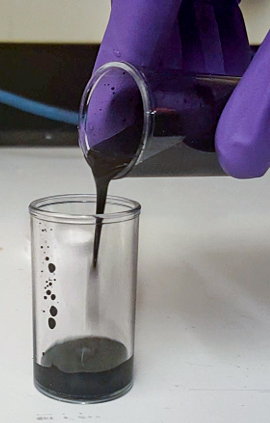Scientists at the Massachusetts Institute of Technology (MIT) have developed a zinc-manganese dioxide (Zn-MnO2) flow battery for long-duration energy storage that might be cheaper than other storage technologies.
The battery's special feature is a new kind of electrode made of a mixture containing dispersed manganese dioxide (MnO2) particles, shot through with an electrically conductive additive, carbon black. The latter was used to add the pigment and the electric punch to the semisolid compound.
“This compound reacts with a conductive zinc solution or zinc plate at the stack, enabling efficient electrochemical energy conversion,” the scientists said. “The fluid properties of this battery are far removed from the watery solutions used by other flow batteries.”
The battery went through tests that showed that it offers an optimal electrochemical mix.
“These systems have to be able to flow under reasonable pressures, but also have a weak yield stress so that the active MnO2 particles don't sink to the bottom of the flow tanks when the system isn’t being used, as well as not separate into a battery/oily clear fluid phase and a dense paste of carbon particles and MnO2,” said researcher Gareth McKinley.
The scientists were surprised by the results of a techno-economic analysis that compared the performance of the battery with an equivalent electrochemical battery and hydrogen backup.
“We performed a comprehensive, bottom-up analysis to understand how the battery’s composition affects performance and cost, looking at all the trade-offs,” said researcher Thaneer Malai Narayanan. “We showed that our system can be cheaper than others, and can be scaled up.”
According to the research, when the compared batteries discharge for more than 24 hours, the semisolid flow battery beats out lithium-ion batteries and vanadium redox flow batteries. “This was true even when factoring in the heavy expense of pumping the MnO2 slurry from tank to stack,” they said.
“The next step is to take our battery system and build it up,” added Narayanan. “Our research also points the way to other chemistries that could be developed under the semi-solid flow battery platform, so we could be seeing this kind of technology used for energy storage in our lifetimes.”
The researchers described the battery in “Low-cost manganese dioxide semi-solid electrode for flow batteries,” which was recently published in Joule.
This content is protected by copyright and may not be reused. If you want to cooperate with us and would like to reuse some of our content, please contact: editors@pv-magazine.com.




2 comments
By submitting this form you agree to pv magazine using your data for the purposes of publishing your comment.
Your personal data will only be disclosed or otherwise transmitted to third parties for the purposes of spam filtering or if this is necessary for technical maintenance of the website. Any other transfer to third parties will not take place unless this is justified on the basis of applicable data protection regulations or if pv magazine is legally obliged to do so.
You may revoke this consent at any time with effect for the future, in which case your personal data will be deleted immediately. Otherwise, your data will be deleted if pv magazine has processed your request or the purpose of data storage is fulfilled.
Further information on data privacy can be found in our Data Protection Policy.